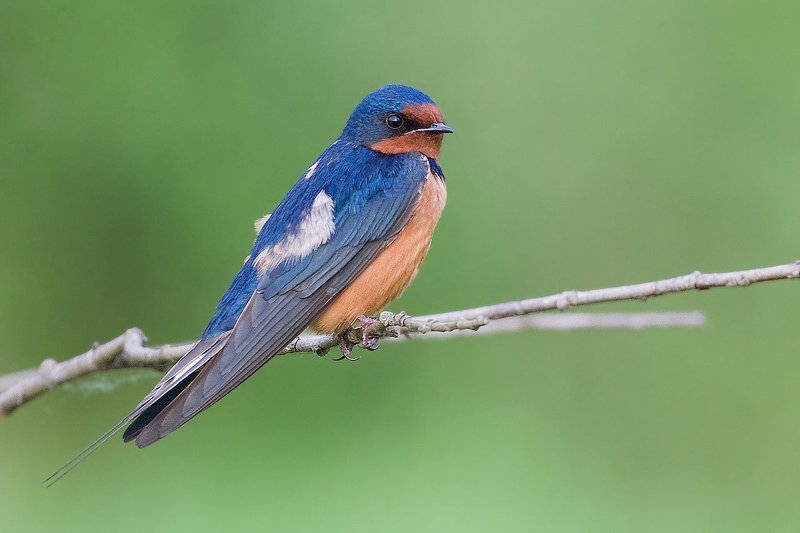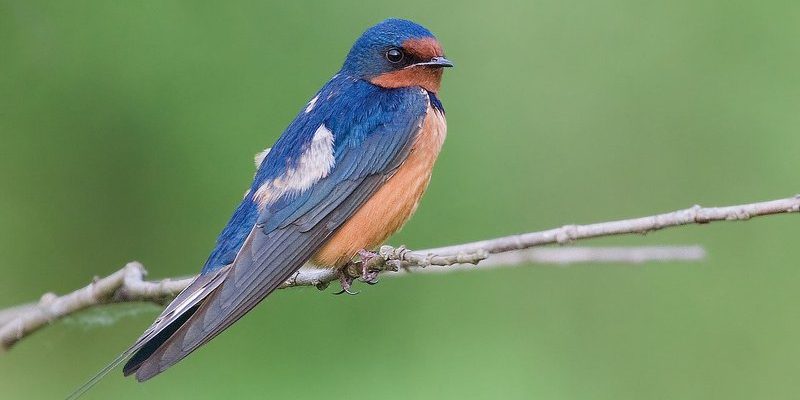
Imagine a bird that dances in the air, turns on a dime, and sings a sweet song while zooming over fields and water. That’s the enchanting Barn Swallow. These small, agile birds are known for their remarkable speed and acrobatic flight. If you’ve ever seen them swooping and diving, you know why they’re often celebrated as one of nature’s skilled fliers.
Barn Swallows belong to the family Hirundinidae and are found almost everywhere across the globe. They take advantage of human structures like barns and bridges to build their nests, making them familiar sights in rural and suburban areas. With their striking blue and orange plumage, they not only catch our eye but also captivate our hearts with their lively behavior.
In this article, we’ll take a closer look at the fascinating world of Barn Swallows, exploring everything from their appearance and behavior to their feeding habits and nesting practices. Whether you’re a birdwatcher or simply curious about nature, there’s something here for everyone.
Physical Characteristics of Barn Swallows
The Barn Swallow is easily recognizable due to its unique features. Adult swallows typically measure about 6.7 to 7.5 inches in length. They sport a long, forked tail that is one of the most distinguishing characteristics of this species. Their wings are long and pointed, allowing for incredible agility in the air. The upper parts of their bodies are a beautiful metallic blue, while their underparts shine a warm orange-brown. It’s easy to see why they’re often called one of the most beautiful birds!
But it’s not just about looks; their physical traits serve practical purposes. Those long wings and tail make them expert flyers, allowing them to dart through the sky with grace. When they swoop low over water or fields, they capture insects mid-flight, showcasing their incredible hunting skills. It’s like watching nature’s own aerial ballets unfold before your eyes.
Juvenile Barn Swallows look a bit different; they have a more muted color palette with less shiny feathers. As they grow, they gradually develop their adult plumage, transforming into the vibrant birds we admire. This change also signals their readiness to take on the world as independent flyers.
Habitat and Distribution
Barn Swallows are quite versatile when it comes to their habitats. They thrive in a range of environments, from rural farmlands to suburban areas, and can often be spotted around human habitats. Their preference for nesting near humans stems from our structures providing safe spaces away from predators—like attics, barns, and bridges!
These birds are migratory, traveling thousands of miles each year. During summer, you’ll find them in North America and Europe, where they breed and raise their young. As the colder months roll in, Barn Swallows head south to warmer climates in Central and South America. Their migration journey is not just a long flight; it’s a remarkable adventure where they rely on their keen sense of direction.
Interestingly, Barn Swallows have adapted to urbanization. You might even spot them darting around city parks or along riverbanks, showcasing their ability to thrive alongside humans. Despite our busy cities, these little birds continue to find ways to make their homes in the nooks and crannies of our buildings.
Feeding Habits of Barn Swallows
When it comes to food, Barn Swallows are expert aerial hunters. Their diet primarily consists of insects, making them valuable allies for farmers and gardeners. They typically feed on small flies, beetles, and other airborne insects, catching them mid-air with their swift and precise movements. You might see them gliding just above the surface of a pond or field, snatching dinner as they go.
Their feeding technique is quite impressive. They use a series of quick, agile maneuvers to catch prey, often flying in loops and dives to snag insects on the wing. This behavior not only showcases their agility but also makes for a mesmerizing spectacle to watch. If you’ve ever seen a group of Barn Swallows feeding together, you know it’s like witnessing a group of dancers in perfect harmony.
During the breeding season, adults often work diligently to feed their young. They catch food and bring it back to the nest, ensuring their chicks have plenty to eat and grow strong. This nurturing behavior highlights their dedication as parents, teaching us the importance of family and care in the animal kingdom.
Nesting and Breeding Behavior
The nesting habits of Barn Swallows are both fascinating and practical. These birds usually build their nests out of mud, grass, and feathers. You’ll often find their nests tucked under eaves, within barn roofs, or on ledges in buildings. The mud helps to create a sturdy structure, while the soft feathers provide a cozy space for their chicks.
It’s interesting to note that Barn Swallows are quite social when it comes to nesting. They often nest in colonies, which not only offers safety in numbers but also a sense of community. This behavior can lead to a lively atmosphere around their nesting sites, filled with chirps and fluttering wings as they come and go.
The female typically lays about three to seven eggs, which are incubated by both parents. After about two weeks, the eggs hatch, and the little ones emerge with their eyes closed and feathers bare. The parents then work tirelessly to feed their chicks, bringing food back to the nest frequently. Soon enough, those tiny, helpless chicks will grow into the spirited flyers we admire in the skies!
Table of Interesting Facts
| Common Name: | Barn Swallow |
| Scientific Name: | Hirundo rustica |
| Size: | 6.7 to 7.5 inches |
| Wingspan: | 12 to 15 inches |
| Diet: | Insects |
| Habitat: | Open fields, near water, and human structures |
| Migration: | North America to Central/South America in winter |
| Lifespan: | About 4 years |
Behavior and Interaction with Humans
Barn Swallows have a fascinating relationship with humans. Their adaptability to urban environments and tendency to nest near human habitats have made them one of the most familiar bird species. Some might even view them as lucky, welcoming signs of spring. Their presence often indicates a healthy environment since they thrive in areas with abundant insects.
These birds are generally non-aggressive and can be quite tame. If you’re lucky, you might find them nesting just outside your window or swooping low across your garden. They often engage in playful aerial displays, diving and chasing each other in what looks like a joyful dance. Observing these interactions can be a delightful experience, reminding us of the beauty of wildlife in our everyday lives.
However, it’s important to respect their space. If you find a nest near your home, it’s best to avoid disturbing it. Barn Swallows are protected by law in many places, and their nests can be a vital part of the local ecosystem. By giving them space, you contribute to the health of your local wildlife and enjoy the benefits of having these charming birds nearby.
Conservation Status
Despite their widespread presence, Barn Swallows face challenges in the modern world. Changes in agricultural practices, loss of nesting habitats, and pesticide use can all impact their populations. However, these birds are still relatively abundant and are classified as “Least Concern” by the IUCN. This status suggests that, for now, they are not at immediate risk of extinction.
Conservation efforts focus on enhancing their habitats and ensuring safe nesting options. Farmers and landowners can play a crucial role by preserving natural areas and nesting sites. Installing bird-friendly structures and minimizing pesticide use can also help maintain healthy populations of these beautiful birds.
By recognizing their importance in the ecosystem, we can all contribute to the conservation of Barn Swallows. These little acrobats are not just pretty to watch; they play a vital role in controlling insect populations and maintaining the balance of our environment.
FAQ
Where do Barn Swallows build their nests?
Barn Swallows typically build their nests in sheltered areas close to human structures, such as barns, bridges, and eaves of buildings. They prefer places that offer protection from predators and the elements, making barns and similar structures ideal environments for raising their young.
How long do Barn Swallows live?
On average, Barn Swallows have a lifespan of about four years, although some can live longer under optimal conditions. Factors such as food availability, habitat quality, and predation can all influence their longevity.
What do Barn Swallows eat besides insects?
While insects make up the bulk of their diet, Barn Swallows may also consume small amounts of other food sources, such as spiders or even small seeds. However, they primarily rely on flying insects, which provide the protein needed for their energy-intensive lifestyle.
Are Barn Swallows aggressive towards humans?
No, Barn Swallows are generally not aggressive towards humans. They are social birds that often tolerate our presence near their nests. However, they may swoop low to defend their nests if they feel threatened, so it’s best to observe them from a respectful distance.
Do Barn Swallows migrate every year?
Yes, Barn Swallows are migratory birds. They typically migrate south for the winter, traveling to regions in Central and South America. In spring, they return to their breeding grounds in North America and Europe, following the seasonal changes.
How many eggs do Barn Swallows lay at a time?
Barn Swallows usually lay three to seven eggs per clutch. The female typically incubates the eggs, while both parents take turns providing food for the chicks once they hatch, showcasing their teamwork.
Can Barn Swallows be found in urban areas?
Yes, Barn Swallows have adapted remarkably well to urban areas. You can often find them nesting near buildings, parks, and waterfronts. Their ability to thrive in diverse environments has made them common sights even in bustling cities.
What sound do Barn Swallows make?
Barn Swallows are known for their cheerful, twittering calls. Their vocalizations can vary, but they often produce a series of soft chirps or trills, especially during courtship displays or when communicating with their young.
How can I attract Barn Swallows to my property?
If you want to attract Barn Swallows to your property, consider providing suitable nesting sites. Installing nesting shelves or creating areas with open spaces will encourage them to settle nearby. Additionally, maintaining a natural environment with abundant insects will make your property more appealing to these delightful birds.
Are Barn Swallows social birds?
Yes, Barn Swallows are very social creatures. They often nest in colonies and can frequently be seen flying together in groups. Their social behavior not only helps with safety from predators but also enhances their communal nesting experience.
What is the significance of Barn Swallows in culture?
Barn Swallows hold cultural significance in various societies. They are often seen as symbols of hope, renewal, and good luck. In many cultures, their arrival signals the beginning of spring, embodying the joy of new beginnings and the beauty of nature.
Do Barn Swallows return to the same nesting site every year?
Many Barn Swallows do tend to return to the same nesting sites each year, provided conditions are favorable. They have strong homing instincts, making them likely to come back to familiar places where they successfully raised their young.

